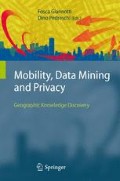Data warehouses have received the attention of the database community as a technology for integrating all sorts of transactional data, dispersed within organisations whose applications utilise either legacy (non-relational) or advanced relational database systems. Data warehouses form a technological framework for supporting decision-making processes by providing informational data. A data warehouse is defined as a subject-oriented, integrated, time-variant, non-volatile collection of data in support of management of decision-making process [10].
Access this chapter
Tax calculation will be finalised at checkout
Purchases are for personal use only
Preview
Unable to display preview. Download preview PDF.
References
S. Agarwal, R. Agrawal, P. Deshpande, A. Gupta, J. Naughton, R. Ramakrishnan, and S. Sarawagi. On the computation of multidimensional aggregates. In Proceeding on 22th International Conference on Very Large Data Bases (VLDB’96), pp. 506–521, 1996.
Y. Bédard, T. Merrett, and J. Han. Fundamentals of spatial data warehousing for geographic knowledge discovery. In Geographic Data Mining and Knowledge Discovery, pp. 53–73. Taylor & Francis, 2001.
S. Bimonte, A. Tchounikine, and M. Miquel. Towards a spatial multi-dimensional model. In Proceedings of ACM 8th International Workshop on Data Warehousing and OLAP (DOLAP’05), pp. 39–46, 2005.
F. Braz, S. Orlando, R. Orsini, A. Raffaetà, A. Roncato, and C. Silvestri. Approximate aggregations in trajectory data warehouses. In Proceedings of ICDE Workshop on Spatio-Temporal Data Mining, pp. 536–545, 2007.
M.-L. Damiani and S. Spaccapietra. Spatial data warehouse modelling. In Processing and Managing Complex Data for Decision Support, pp. 12–27. Idea Group Publishing, 2006.
P. Flajolet and G. Martin. Probabilistic counting algorithms for data base applications. Journal of Computer and System Sciences, 31(2):182–209, 1985.
J. Gray, A. Bosworth, A. Layman, and H. Pirahesh. Data cube: A relational aggregation operator generalizing group-by, cross-tab, and sub-total. In Proceedings of the 12th International Conference on Data Engineering (ICDE’96), pp. 152–159, 1996.
J. Han, N. Stefanovic, and K. Kopersky. Selective materialization: An efficient method for spatial data cube construction. In Proceedings of Pacific-Asia Conference on Knowledge Discovery and Data Mining, pp. 144–158, 1998.
K. Hornsby and M. Egenhofer. Modeling moving objects over multiple granularities. Annals of Mathematics and Artificial Intelligence, 36(1–2):177–194, 2002.
W. Inmon. Building the Data Warehouse, 2nd edn. Wiley, 1996.
C. Jensen, A. Kligys, T. Pedersen, C. Dyreson, and I. Timko. Multidimensional data modeling for location-based services. The Very Large Data Bases Journal, 13:1–21, 2004.
I. Lopez, R. Snodgrass, and B. Moon. Spatiotemporal aggregate computation: A survey. IEEE Transactions o Knowledge Data Engeneering, 2(17):271–286, 2005.
E. Malinowski and E. Zimányi. OLAP hierarchies: A conceptual perspective. In Proceedings of the 16th International Conference on Advanced Information Systems Engineering (CAiSE’04), pp. 477–491, 2004.
E. Malinowski and E. Zimányi. Representing spatiality in a conceptual multidimensional model. In Proceedings of the 12th annual International Workshop on Geographic Information Systems (GIS’04), pp. 12–21, 2004.
E. Malinowski and E. Zimányi. Hierarchies in a multidimensional model: From conceptual modeling to logical representation. Data and Knowledge Engineering, 59(2):348–377, 2006.
OpenGIS Consortium. Abstract Specification, Topic 1: Feature Geometry (ISO 19107 Spatial Schema), 2001. http://www.opengeospatial.org.
D. Papadias, Y. Tao, P. Kalnis, and J. Zhang. Indexing spatio-temporal data warehouses. In Proceedings of the 18th International Conference on Data Engineering (ICDE’02), pp. 166–175, 2002.
T. Pedersen and N. Tryfona. Pre-aggregation in spatial data warehouses. In Proceedings of the 5th International Symposium on Spatial and Temporal Databases (SSTD’01), vol. 2121 of LNCS, pp. 460–480, 2001.
F. Rao, L. Zhang, X. Yu, Y. Li, and Y. Chen. Spatial hierarchy and OLAP-favored search in spatial data warehouse. In Proceedings of ACM 6th International Workshop on Data Warehousing and OLAP (DOLAP’03), pp. 48–55, 2003.
S. Rivest, Y. Bédard, and P. Marchand. Towards better support for spatial decision making: Defining the characteristics of spatial on-line analytical processing (SOLAP). Geomatica, 55(4):539–555, 2001.
S. Rivest, Y. Bédard, M. Proulx, M. Nadeau, F. Hubert, and J. Pastor. SOLAP: Merging business intelligence with geospatial technology for interactive spatio-temporal exploration and analysis of data. Journal of International Society for Photogrammetry & Remote Sensing, 60(1):17–33, 2005.
S. Rizzi. Open problems in data warehousing: Eight years later. In Proceedings of the 5th Workshop on Design and Management of Data Warehouses (DMDW’03), 2003.
S. Rizzi and M. Golfarelli. Date warehouse design. In Proceedings of International Conference on Enterprise Information Systems (ICEIS’00), pp. 39–42, 2000.
S. Shekhar, C. Lu, S. Chawla, and P. Zhang. Data mining and visualization of twin-cities traffic data. Technical Report, University of Minnesota, 2002.
N. Stefanovic, J. Han, and K. Koperski. Object-based selective materialization for efficient implementation of spatial data cubes. IEEE Transactions on Knowledge and Data Engineering, 12(6):938–958, 2000.
Y. Tao, G. Kollios, J. Considine, F. Li, and D. Papadias. Spatio-temporal aggregation using sketches. In Proceedings of the 20th International Conference on Data Engineering (ICDE’04), pp. 214–225, 2004.
Y. Tao and D. Papadias. Historical spatio-temporal aggregation. ACM Transactions on Information Systems, 23:61–102, 2005.
G. Trajcevski, O. Wolfson, K. Hinrichs, and S. Chamberlain. Managing uncertainty in moving objects databases. ACM Transactions on Database System, 29(3):463–507, 2004.
G. Trajcevski, O. Wolfson, F. Zhang, and S. Chamberlain. The geometry of uncertainty in moving objects databases. In Proceedings of 7th International Conference on Extending Database Technology (EDBT’02), pp. 233–250, 2002.
J. Trujillo, M. Palomar, J. Gómez, and I. Song. Designing data warehouses with OO conceptual models. IEEE Computer, Special Issue on Data Warehouses, 34(12):66–75, 2001.
P. Vassiliadis and T. Sellis. A survey of logical models for OLAP databases. SIGMOD Record, 28(4):64–69, 1999.
D. Zhang and V. Tsotras. Optimizing spatial Min/Max aggregations. The Very Large Data Bases Journal, 14:170–181, 2005.
Author information
Authors and Affiliations
Editor information
Editors and Affiliations
Rights and permissions
Copyright information
© 2008 Springer-Verlag Berlin Heidelberg
About this chapter
Cite this chapter
Pelekis, N. et al. (2008). Towards Trajectory Data Warehouses. In: Giannotti, F., Pedreschi, D. (eds) Mobility, Data Mining and Privacy. Springer, Berlin, Heidelberg. https://doi.org/10.1007/978-3-540-75177-9_8
Download citation
DOI: https://doi.org/10.1007/978-3-540-75177-9_8
Publisher Name: Springer, Berlin, Heidelberg
Print ISBN: 978-3-540-75176-2
Online ISBN: 978-3-540-75177-9
eBook Packages: Computer ScienceComputer Science (R0)

